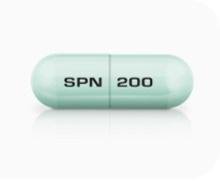Qelbree Side Effects
Generic name: viloxazine
Note: This document contains side effect information about viloxazine. Some dosage forms listed on this page may not apply to the brand name Qelbree.
Applies to viloxazine: oral capsule extended release.
Warning
Oral route (Capsule)
Warning: Suicidal Thoughts and BehaviorsIn clinical studies, higher rates of suicidal thoughts and behavior were reported in patients with ADHD treated with viloxazine than in patients treated with placebo. Closely monitor all viloxazine-treated patients for clinical worsening, and for emergence of suicidal thoughts and behaviors.
Serious side effects of Qelbree
Along with its needed effects, viloxazine (the active ingredient contained in Qelbree) may cause some unwanted effects. Although not all of these side effects may occur, if they do occur they may need medical attention.
Check with your doctor immediately if any of the following side effects occur while taking viloxazine:
More common
- Sleepiness or unusual drowsiness
Less common
- Body aches or pain
- chills
- cough
- ear congestion
- fast, pounding, or irregular heartbeat or pulse
- fever
- headache
- hoarseness
- loss of voice
- muscle aches
- pain or tenderness around the eyes and cheekbones
- relaxed and calm
- sneezing
- sore throat
- stuffy or runny nose
- tender, swollen glands in the neck
- tightness of the chest
- trouble breathing or swallowing
- unusual dullness or feeling of sluggishness
- unusual tiredness or weakness
- voice changes
Other side effects of Qelbree
Some side effects of viloxazine may occur that usually do not need medical attention. These side effects may go away during treatment as your body adjusts to the medicine. Also, your health care professional may be able to tell you about ways to prevent or reduce some of these side effects.
Check with your health care professional if any of the following side effects continue or are bothersome or if you have any questions about them:
Less common
Incidence not known
- Weight changes
For Healthcare Professionals
Applies to viloxazine: oral capsule extended release.
General
The most reported adverse reactions have included somnolence, decreased appetite, fatigue, nausea, vomiting, insomnia, and irritability. The adverse reactions most commonly associated with discontinuation were somnolence, nausea, headache, irritability, tachycardia, fatigue, and decreased appetite.[Ref]
Nervous system
In short-term, placebo-controlled clinical trials, somnolence (including lethargy and sedation) was reported in 16% of treated patients compared to 4% of placebo patients.
Very common (10% or more): Somnolence (16%), headache (11%)
Cardiovascular
In patients 6 to 11 years (n=154), 22% of patients treated with this drug at 100 mg/day had a 20 beat per minute (bpm) or greater increase in heart rate at any time point in the clinical trial, compared to 9% of placebo patients (n=159). For the 200 mg dose, an increase in bpm was found in 31% (84/268) of patients receiving the drug compared to 15% (39/262) in the placebo group. These number were 28% (28/100) and 23% (24/103) for patients receiving 400 mg/day and placebo, respectively. For patients 12 to 17 years receiving 200 mg/day, 22% (22/99) had a 20 bpm increase in heart rate at any point in the clinical trial compared to 15/104 (14%) of patients who received placebo. For the 400 mg dose, the percentages were 34% (69/205) and 17% (35/201) in treated patients and placebo, respectively. For patients 12 to 17 years, 25% (52/205) of patients receiving 400 mg/day had a 15 mmHg or greater increase in diastolic blood pressure at any time in the clinical trial, compared to 13% (26/201) of patients in the placebo group.
Very common (10% or more): Increase in heart rate (22%), increase in blood pressure (25%)
Other
Common (1% to 10%): Fatigue, pyrexia
Metabolic
In short-term, controlled studies (6 to 8 weeks), patients 6 to 11 years gained an average of 0.2 kg compared to a gain of 1 kg in same-aged patients who received placebo. For patients 12 to 17 years, an average of 0.2 kg was lost compared to a weight gain of 1.5 kg in same-aged patients who received placebo.
Common (1% to 10%): Decreased appetite
Frequency not reported: Weight changes
Respiratory
Common (1% to 10%): Upper respiratory tract infection
Gastrointestinal
Common (1% to 10%): Abdominal pain, nausea, vomiting
Psychiatric
Common (1% to 10%): Insomnia, irritability
Uncommon (0.1% to 1%): Suicidal ideation, behavior, or both
In short-term trials, a total of nine patients (0.9%) reported suicidal ideation (n=6), behavior (n=1) or both (n=2). Eight patients reported suicidal ideation or behavior on the Columbia Suicide Severity Rating Scale (C-SSRS), a validated scale that assesses suicide risk. An additional patient treated with this drug reported suicidal behavior during the clinical trials but did not report it on the C-SSRS. Among 463 patients treated with placebo in these studies, two patients (0.4%) reported suicidal ideation on the C-SSRS. No patients treated with placebo reported suicidal behavior. No completed suicides occurred in these trials.
Frequently asked questions
- Qelbree vs. Strattera: How do they compare?
- Qelbree vs Adderall: What's the difference between them?
More about Qelbree (viloxazine)
- Check interactions
- Compare alternatives
- Pricing & coupons
- Reviews (39)
- Drug images
- Dosage information
- During pregnancy
- FDA approval history
- Drug class: adrenergic uptake inhibitors for ADHD
- Breastfeeding
- En español
Patient resources
Professional resources
Related treatment guides
References
1. Product Information. Qelbree (viloxazine). Supernus Pharmaceuticals Inc. 2021.
Further information
Always consult your healthcare provider to ensure the information displayed on this page applies to your personal circumstances.
Some side effects may not be reported. You may report them to the FDA.

